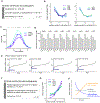Transcriptional and chromatin-based partitioning mechanisms uncouple protein scaling from cell size
- PMID: 34731644
- PMCID: PMC8642314
- DOI: 10.1016/j.molcel.2021.10.007
Transcriptional and chromatin-based partitioning mechanisms uncouple protein scaling from cell size
Abstract
Biosynthesis scales with cell size such that protein concentrations generally remain constant as cells grow. As an exception, synthesis of the cell-cycle inhibitor Whi5 "sub-scales" with cell size so that its concentration is lower in larger cells to promote cell-cycle entry. Here, we find that transcriptional control uncouples Whi5 synthesis from cell size, and we identify histones as the major class of sub-scaling transcripts besides WHI5 by screening for similar genes. Histone synthesis is thereby matched to genome content rather than cell size. Such sub-scaling proteins are challenged by asymmetric cell division because proteins are typically partitioned in proportion to newborn cell volume. To avoid this fate, Whi5 uses chromatin-binding to partition similar protein amounts to each newborn cell regardless of cell size. Disrupting both Whi5 synthesis and chromatin-based partitioning weakens G1 size control. Thus, specific transcriptional and partitioning mechanisms determine protein sub-scaling to control cell size.
Keywords: cell cycle; cell size; cell size control; gene expression; scaling.
Copyright © 2021 Elsevier Inc. All rights reserved.
Conflict of interest statement
Declaration of interests The authors declare no competing interests.
Figures







Similar articles
-
Cln3 activates G1-specific transcription via phosphorylation of the SBF bound repressor Whi5.Cell. 2004 Jun 25;117(7):887-98. doi: 10.1016/j.cell.2004.05.025. Cell. 2004. PMID: 15210110
-
CDK activity antagonizes Whi5, an inhibitor of G1/S transcription in yeast.Cell. 2004 Jun 25;117(7):899-913. doi: 10.1016/j.cell.2004.05.024. Cell. 2004. PMID: 15210111
-
Dilution of the cell cycle inhibitor Whi5 controls budding-yeast cell size.Nature. 2015 Oct 8;526(7572):268-72. doi: 10.1038/nature14908. Epub 2015 Sep 21. Nature. 2015. PMID: 26390151 Free PMC article.
-
Regulation of entry into gametogenesis.Philos Trans R Soc Lond B Biol Sci. 2011 Dec 27;366(1584):3521-31. doi: 10.1098/rstb.2011.0081. Philos Trans R Soc Lond B Biol Sci. 2011. PMID: 22084379 Free PMC article. Review.
-
Chromatin-remodeling and the initiation of transcription.Q Rev Biophys. 2015 Nov;48(4):465-70. doi: 10.1017/S0033583515000116. Q Rev Biophys. 2015. PMID: 26537406 Review.
Cited by
-
Genome dilution by cell growth drives starvation-like proteome remodeling in mammalian and yeast cells.Nat Struct Mol Biol. 2024 Dec;31(12):1859-1871. doi: 10.1038/s41594-024-01353-z. Epub 2024 Jul 24. Nat Struct Mol Biol. 2024. PMID: 39048803
-
Characterization of proteome-size scaling by integrative omics reveals mechanisms of proliferation control in cancer.Sci Adv. 2023 Jan 25;9(4):eadd0636. doi: 10.1126/sciadv.add0636. Epub 2023 Jan 25. Sci Adv. 2023. PMID: 36696495 Free PMC article.
-
Whi5 hypo- and hyper-phosphorylation dynamics control cell-cycle entry and progression.Curr Biol. 2024 Jun 3;34(11):2434-2447.e5. doi: 10.1016/j.cub.2024.04.052. Epub 2024 May 14. Curr Biol. 2024. PMID: 38749424 Free PMC article.
-
Nucleosome proteostasis and histone turnover.Front Mol Biosci. 2022 Sep 30;9:990006. doi: 10.3389/fmolb.2022.990006. eCollection 2022. Front Mol Biosci. 2022. PMID: 36250018 Free PMC article. Review.
-
Coupling gene expression dynamics to cell size dynamics and cell cycle events: Exact and approximate solutions of the extended telegraph model.iScience. 2022 Dec 7;26(1):105746. doi: 10.1016/j.isci.2022.105746. eCollection 2023 Jan 20. iScience. 2022. PMID: 36619980 Free PMC article.
References
-
- Andrews BJ, and Herskowitz I (1989). Identification of a DNA binding factor involved in cell-cycle control of the yeast HO gene. Cell 57, 21–29. - PubMed
Publication types
MeSH terms
Substances
Grants and funding
LinkOut - more resources
Full Text Sources
Research Materials

